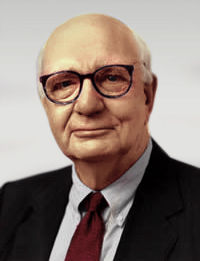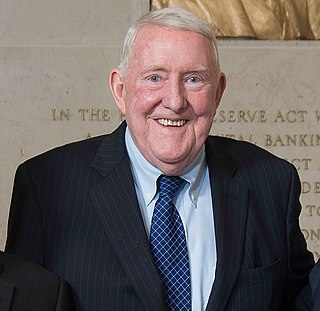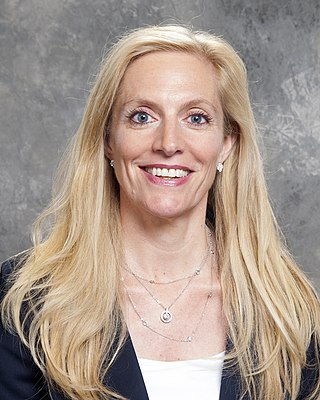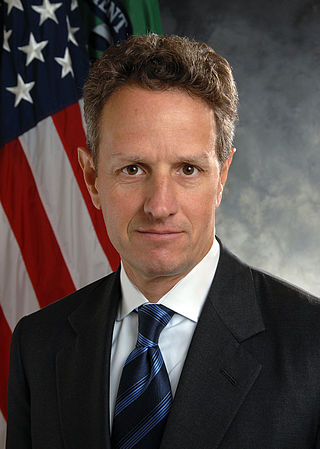
The Federal Reserve System is the central banking system of the United States of America. It was created on December 23, 1913, with the enactment of the Federal Reserve Act, after a series of financial panics led to the desire for central control of the monetary system in order to alleviate financial crises. Over the years, events such as the Great Depression in the 1930s and the Great Recession during the 2000s have led to the expansion of the roles and responsibilities of the Federal Reserve System.

The chair of the Board of Governors of the Federal Reserve System is the head of the Federal Reserve, and is the active executive officer of the Board of Governors of the Federal Reserve System. The chair shall preside at the meetings of the Board.

Paul Adolph Volcker Jr. was an American economist who served as the 12th chairman of the Federal Reserve from 1979 to 1987. During his tenure as chairman, Volcker was widely credited with having ended the high levels of inflation seen in the United States throughout the 1970s and early 1980s. He previously served as the president of the Federal Reserve Bank of New York from 1975 to 1979.
The Federal Open Market Committee (FOMC), a committee within the Federal Reserve System, is charged under United States law with overseeing the nation's open market operations. This Federal Reserve committee makes key decisions about interest rates and the growth of the United States money supply. Under the terms of the original Federal Reserve Act, each of the Federal Reserve banks was authorized to buy and sell in the open market bonds and short term obligations of the United States Government, bank acceptances, cable transfers, and bills of exchange. Hence, the reserve banks were at times bidding against each other in the open market. In 1922, an informal committee was established to execute purchases and sales. The Banking Act of 1933 formed an official FOMC.

Janet Louise Yellen is an American economist serving as the 78th United States secretary of the treasury since January 26, 2021. She previously served as the 15th chair of the Federal Reserve from 2014 to 2018. Yellen is the first woman to hold each of those posts and the first person to have led the White House Council of Economic Advisers, the Federal Reserve, and the Treasury Department.

George William Miller was an American businessman and investment banker who served as the 65th United States secretary of the treasury from 1979 to 1981. A member of the Democratic Party, he also served as the 11th chairman of the Federal Reserve from 1978 to 1979. Miller was the first person to hold both of those posts.

The Federal Reserve Bank of New York is one of the 12 Federal Reserve Banks of the United States. It is responsible for the Second District of the Federal Reserve System, which encompasses the State of New York, the 12 northern counties of New Jersey, Fairfield County in Connecticut, Puerto Rico, and the U.S. Virgin Islands. Located at 33 Liberty Street in Lower Manhattan, it is by far the largest, the most active, and the most influential of the Reserve Banks.

Edward Gerald Corrigan was an American banker who was the seventh President of the Federal Reserve Bank of New York and Vice-Chairman of the Federal Open Market Committee. Corrigan served as a partner and managing director in the Office of the Chairman at Goldman Sachs and was appointed chairman of GS Bank USA, the bank holding company of Goldman Sachs, in September 2008 until retiring in 2016. He was also a member of the Group of Thirty, an influential international body of leading financiers and academics.

Kevin Maxwell Warsh is an American financier and bank executive who served as a member of the Federal Reserve Board of Governors from 2006 to 2011. During and in the aftermath of the 2008 financial crisis, Warsh acted as the central bank's primary liaison to Wall Street and served as the Federal Reserve's representative to the Group of Twenty (G-20) and as the Board's emissary to the emerging and advanced economies in Asia. Prior, he served as Special Assistant to the President for Economic Policy and Executive Secretary of the White House National Economic Council. He is the Shepard Family Distinguished Visiting Fellow in Economics at Stanford University's Hoover Institution, a scholar and lecturer at the Stanford Graduate School of Business, a member of the Group of Thirty, a member of the Panel of Economic Advisers of the Congressional Budget Office, and a former steering committee member of the Bilderberg Group. He has conducted research in the field of economics and finance, and has advised several private and public companies.

The Under Secretary of the Treasury for International Affairs is a senior position within the United States Department of the Treasury responsible for advising the Secretary of the Treasury on international economic issues. During the Trump Administration the office was held by Brent McIntosh following the appointment of David Malpass to lead the World Bank. As of June 2021, the office is vacant.

William Poole was the eleventh chief executive of the Federal Reserve Bank of St. Louis. He took office on March 23, 1998 and began serving his full term on March 1, 2001. In 2007, he served as a voting member of the Federal Open Market Committee, bringing his District's perspective to policy discussions in Washington. Poole stepped down from the Fed on March 31, 2008.

This is a list of historical rate actions by the United States Federal Open Market Committee (FOMC). The FOMC controls the supply of credit to banks and the sale of treasury securities. The Federal Open Market Committee meets every two months during the fiscal year. At scheduled meetings, the FOMC meets and makes any changes it sees as necessary, notably to the federal funds rate and the discount rate. The committee may also take actions with a less firm target, such as an increasing liquidity by the sale of a set amount of Treasury bonds, or affecting the price of currencies both foreign and domestic by selling dollar reserves. Jerome Powell is the current chairperson of the Federal Reserve and the FOMC.
This article is about the history of the United States Federal Reserve System from its creation to the present.

Lael Brainard is an American economist serving as the 22nd Vice Chair of the Federal Reserve since May 23, 2022. Prior to her term as vice chair, Brainard served as a member of the Federal Reserve Board of Governors since 2014. She previously served as the United States Under Secretary of the Treasury for International Affairs from 2010 to 2013.
Jamie B. Stewart, Jr. was previously President and CEO of the Federal Farm Credit Banks Funding Corporation, based in Jersey City, NJ., since January 2004.
The Term Asset-Backed Securities Loan Facility (TALF) is a program created by the U.S. Federal Reserve to spur consumer credit lending. The program was announced on November 25, 2008, and was to support the issuance of asset-backed securities (ABS) collateralized by student loans, auto loans, credit card loans, and loans guaranteed by the Small Business Administration (SBA). Under TALF, the Federal Reserve Bank of New York authorized up to $200 billion of loans on a non-recourse basis to holders of certain AAA-rated ABS backed by newly and recently originated consumer and small business loans. As TALF money did not originate from the U.S. Treasury, the program did not require congressional approval to disburse funds, but an act of Congress forced the Fed to reveal how it lent the money. The TALF began operation in March 2009 and was closed on June 30, 2010. TALF 2 was initiated in 2020 during the COVID-19 pandemic.

Timothy Franz Geithner is a former American central banker who served as the 75th United States Secretary of the Treasury under President Barack Obama from 2009 to 2013. He was the President of the Federal Reserve Bank of New York from 2003 to 2009, following service in the Clinton administration. Since March 2014, he has served as president and managing director of Warburg Pincus, a private equity firm headquartered in New York City.

William C. Dudley is an American economist who served as the president of Federal Reserve Bank of New York from 2009 to 2018 and as vice-chairman of the Federal Open Market Committee. He was appointed to the position on January 27, 2009, following the confirmation of his predecessor, Timothy F. Geithner, as United States Secretary of the Treasury.
The U.S.–China Strategic and Economic Dialogue (S&ED) is a high-level dialogue for the United States and China to discuss a wide range of regional and global strategic and economic issues between both countries. The establishment of the S&ED was announced on April 1, 2009, by U.S. President Barack Obama and Chinese President Hu Jintao. The upgraded mechanism replaced the former Senior Dialogue and Strategic Economic Dialogue started under the George W. Bush administration. The format is such that high-level representatives of both countries and their delegations will meet annually at capitals alternating between the two countries.

The Volcker Rule is § 619 of the Dodd–Frank Wall Street Reform and Consumer Protection Act. The rule was originally proposed by American economist and former United States Federal Reserve Chairman Paul Volcker to restrict United States banks from making certain kinds of speculative investments that do not benefit their customers. Volcker argued that such speculative activity played a key role in the financial crisis of 2007–2008. The rule is often referred to as a ban on proprietary trading by commercial banks, whereby deposits are used to trade on the bank's own accounts, although a number of exceptions to this ban were included in the Dodd–Frank law.
























